- Home
- About Us
- Industry
- Services
- Reading
- Contact Us
Dairy Alternatives Market: Current Analysis and Forecast (2024-2032)
Emphasis on Source (Soy, Almond, Coconut, and Others); Product Category (Milk, Yogurt, Ice-cream, and Others); Formulation (Plain and Flavored); and Region/Country
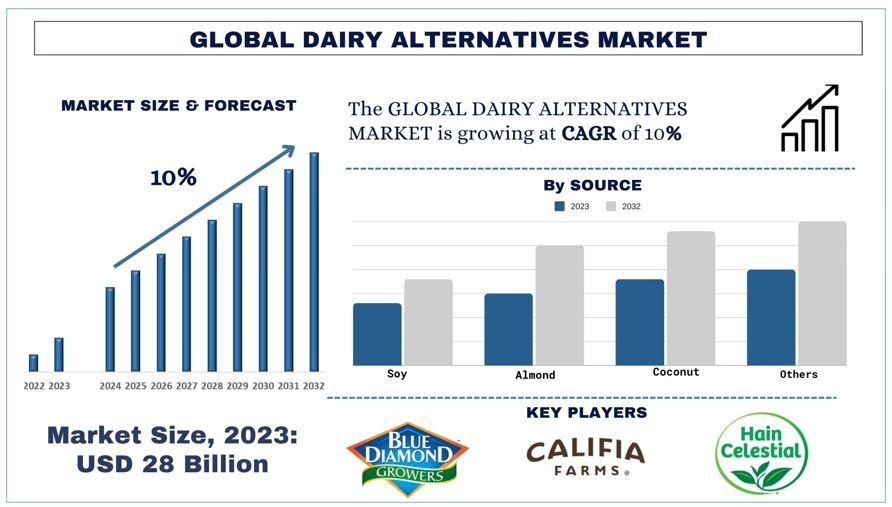
Dairy Alternatives Market Forecast & Size
The dairy alternatives market was valued at approximately ~USD 28 Billion in 2023 and is expected to grow at a strong CAGR of around 10% during the forecast period (2024-2032) owing to the rising demand for plant-based products.
Dairy Alternatives Market Analysis
The dairy alternatives market has grown significantly recently, driven by increasing consumer interest in vegan diets. Increased consumer focus on fashion and trends has boosted demand for dairy alternatives. Also, the growing cases of lactose intolerance among youngsters have influenced the dairy alternatives market. Company collaborations, acquisitions, and innovative product launches also drive the industry’s growth.
For instance, in January 2024, U.S.-based MPearlRock acquired non-dairy creamer Nutpods from VMG Partners.
Also, in May 2023, Canada-based Above Foods merged with Bite Acquisition Corporation. Bite is expected to pay approximately USD 44 million in the proposed transaction, and Above Foods is set to become a public company on the New York Stock Exchange.
Dairy Alternatives Market Trends
This section discusses the key market trends that are influencing the various segments of the dairy alternatives market, as identified by our team of research experts.
Almond Segment Transforming Industry
The increased popularity of almond milk in the luxury market is a shift in customer’s changing attitudes toward veganism. The segment’s growth is boosted by the rising population of lactose-intolerant people and growing product innovations in the market. For instance, in December 2023, Blue Diamond, the world’s leading producer and marketer of almonds, announced a new addition to its selection of Almond Breeze products with the launch of Almond Breeze Original Almond & Oat Blend. This has led to luxury resale platforms adopting this approach by expanding their inventory and producing plant-based dairy alternatives. Almond milk is nutritious, pleasant, low-calorie, and creamy, just like regular milk. It helps strengthen bones and lower the risk of cardiovascular disorders as it is unsweetened milk and does not raise blood sugar. Almond milk is also high in vitamin D, which reduces the risk of brittle bones, fatigue, and weak muscles. This way, the almond milk category got the much-needed boost in the market in the year 2023.
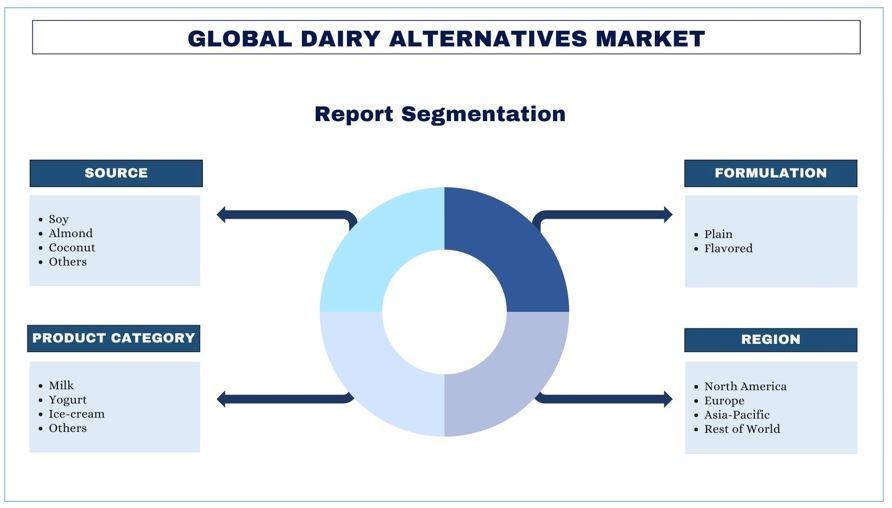
North America is Expected to Grow with Significant CAGR During Forecast Period
Within North America, the U.S. holds a major share of the market. The region’s rapid urbanization, rising investments in the consumer goods industry, the growing demand for plant-based products, innovative marketing strategies, company acquisitions, and the presence of several market players are the major factors boosting the market’s growth in the country.
In January 2023, Canada-based Plant Veda, an award-winning dairy-alternative food manufacturer acquired Nora’s Non-Dairy Ltd pursuant to the terms of a share purchase agreement.
In May 2021, Canada-based Saputo Inc. had two strategic acquisitions in each of the dairy alternatives and value-added ingredients segments of Bute Island Foods and Reedsburg facility of Wisconsin Specialty Protein, LLC, representing a combined investment of approximately USD 136 million.
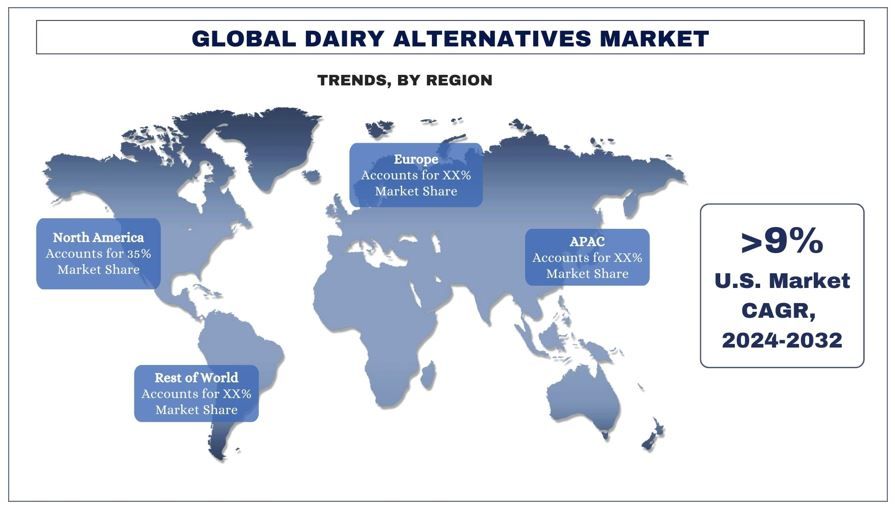
Dairy Alternatives Industry Overview
The dairy alternatives market is competitive, with several global and international market players. The key players are adopting different growth strategies to enhance their market presence, such as partnerships, agreements, collaborations, new product launches, geographical expansions, and mergers and acquisitions. Some of the major players operating in the market are Blue Diamond Growers; Califia Farms, LLC; Danone S.A.; OATLY, INC.; Saputo Inc.; The Hain Celestial Group, Inc.; VBites; Vitasoy International Holdings Ltd; SunOpta; Eden Foods.
In December 2023, Superfood brand Nourish You acquired the vegan dairy brand One Good to help Nourish You evolve from being a superfood brand to a plant-based brand.
In December 2023, Kerry Group plc, the global taste & nutrition company, acquired part of the global lactase enzyme business of Chr. Hansen Holding A/S and Novozymes A/S on a carve out basis. This acquisition is subject to European Commission approval of Kerry as a buyer and forms part of the Novozymes and Chr. Hansen merger approval process.
In March 2023, food tech company Next Gen Foods acquired Mwah – a UK-based start-up dedicated to making dairy-inspired products from plant-based ingredients.
Dairy Alternatives Market Report Coverage
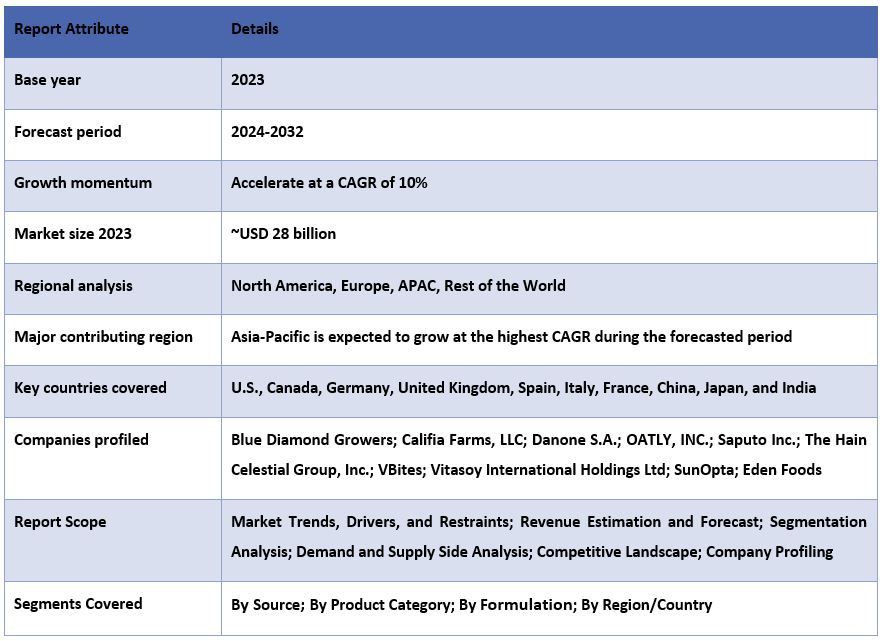
Reasons to buy this report:
- The study includes market sizing and forecasting analysis validated by authenticated key industry experts.
- The report presents a quick review of overall industry performance at one glance.
- The report covers an in-depth analysis of prominent industry peers with a primary focus on key business financials, type portfolios, expansion strategies, and recent developments.
- Detailed examination of drivers, restraints, key trends, and opportunities prevailing in the industry.
- The study comprehensively covers the market across different segments.
- Deep dive regional level analysis of the industry.
Customization Options:
The global dairy alternatives market can further be customized as per the requirement or any other market segment. Besides this, UMI understands that you may have your own business needs, hence feel free to connect with us to get a report that completely suits your requirements.
Table of Content
Research Methodology for the Dairy Alternatives Market Analysis (2024-2032)
Analyzing the historical market, estimating the current market, and forecasting the future market of the global dairy alternatives market were the three major steps undertaken to create and analyze the adoption of dairy alternatives in major regions globally. Exhaustive secondary research was conducted to collect the historical market numbers and estimate the current market size. Secondly, to validate these insights, numerous findings and assumptions were taken into consideration. Moreover, exhaustive primary interviews were also conducted, with industry experts across the value chain of the global dairy alternatives market. Post assumption and validation of market numbers through primary interviews, we employed a top-down/bottom-up approach to forecasting the complete market size. Thereafter, market breakdown and data triangulation methods were adopted to estimate and analyze the market size of segments and sub-segments of the industry pertains to. Detailed methodology is explained below:
Analysis of Historical Market Size
Step 1: In-Depth Study of Secondary Sources:
Detail secondary study was conducted to obtain the historical market size of the dairy alternatives market through company internal sources such as annual reports & financial statements, performance presentations, press releases, etc., and external sources including journals, news & articles, government publications, competitor publications, sector reports, third-party database, and other credible publications.
Step 2: Market Segmentation:
After obtaining the historical market size of the dairy alternatives market, we conducted a detailed secondary analysis to gather historical market insights and share for different segments & sub-segments for major regions. Major segments are included in the report, such as source, product category, formulation, and regions. Further country-level analyses were conducted to evaluate the overall adoption of testing models in that region.
Step 3: Factor Analysis:
After acquiring the historical market size of different segments and sub-segments, we conducted a detailed factor analysis to estimate the current market size of the dairy alternatives market. Further, we conducted factor analysis using dependent and independent variables such as source, product category, formulation, and regions of the dairy alternatives market. A thorough analysis was conducted for demand and supply-side scenarios considering top partnerships, mergers and acquisitions, business expansion, and type launches in the dairy alternatives market sector across the globe.
Current Market Size Estimate & Forecast
Current Market Sizing: Based on actionable insights from the above 3 steps, we arrived at the current market size, key players in the global dairy alternatives market, and market shares of the segments. All the required percentage shares split, and market breakdowns were determined using the above-mentioned secondary approach and were verified through primary interviews.
Estimation & Forecasting: For market estimation and forecast, weights were assigned to different factors including drivers & trends, restraints, and opportunities available for the stakeholders. After analyzing these factors, relevant forecasting techniques i.e., the top-down/bottom-up approach were applied to arrive at the market forecast for 2032 for different segments and sub-segments across the major markets globally. The research methodology adopted to estimate the market size encompasses:
- The industry’s market size, in terms of revenue (USD) and the adoption rate of the dairy alternatives market across the major markets domestically
- All percentage shares, splits, and breakdowns of market segments and sub-segments
- Key players in the global dairy alternatives market in terms of types offered. Also, the growth strategies adopted by these players to compete in the fast-growing market
Market Size and Share Validation
Primary Research: In-depth interviews were conducted with the Key Opinion Leaders (KOLs) including Top Level Executives (CXO/VPs, Sales Head, Marketing Head, Operational Head, Regional Head, Country Head, etc.) across major regions. Primary research findings were then summarized, and statistical analysis was performed to prove the stated hypothesis. Inputs from primary research were consolidated with secondary findings, hence turning information into actionable insights.
Split of Primary Participants in Different Regions
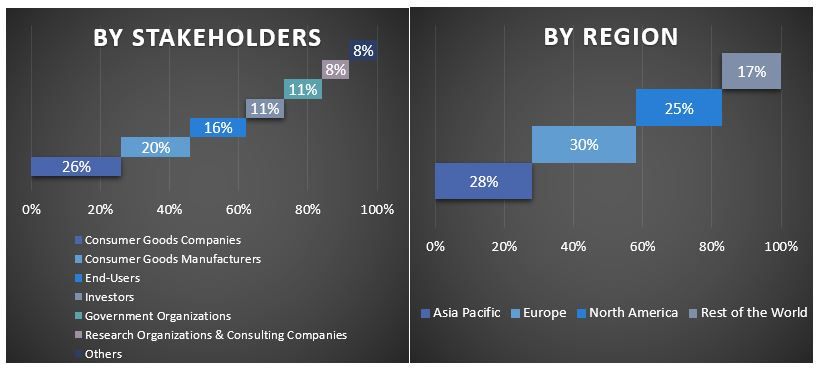
Market Engineering
The data triangulation technique was employed to complete the overall market estimation and to arrive at precise statistical numbers for each segment and sub-segment of the global dairy alternatives market. Data was split into several segments and sub-segments after studying various parameters and trends in the areas of the source, product category, formulation, and regions in the global dairy alternatives market.
The main objective of the Global Dairy Alternatives Market Study
The current & future market trends of the global dairy alternatives market were pinpointed in the study. Investors can gain strategic insights to base their discretion for investments on the qualitative and quantitative analysis performed in the study. Current and future market trends determined the overall attractiveness of the market at a regional level, providing a platform for the industrial participant to exploit the untapped market to benefit from a first-mover advantage. Other quantitative goals of the studies include:
- Analyze the current and forecast market size of the dairy alternatives market in terms of value (USD). Also, analyze the current and forecast market size of different segments and sub-segments.
- Segments in the study include areas of the source, product category, formulation, and regions.
- Define and analysis of the regulatory framework for the dairy alternatives
- Analyze the value chain involved with the presence of various intermediaries, along with analyzing customer and competitor behaviors of the industry.
- Analyze the current and forecast market size of the dairy alternatives market for the major region.
- Major countries of regions studied in the report include Asia Pacific, Europe, North America, and the Rest of the World
- Company profiles of the dairy alternatives market and the growth strategies adopted by the market players to sustain in the fast-growing market.
- Deep dive regional level analysis of the industry
Frequently Asked Questions FAQs
Q1: What are the dairy alternatives current market size and growth potential?
Q2: What are the driving factors for the growth of the dairy alternatives market?
Q3: Which segment has the largest share of the dairy alternatives market by product category?
Q4: What are the emerging technologies and trends in the dairy alternatives market?
Q5: Which region will dominate the dairy alternatives market?
Related Reports
Customers who bought this item also bought










